Kivy是Python中与平台无关的GUI工具。由于它可以在Android, IOS, Linux和Windows等操作系统上运行。它基本上是用于开发Android应用程序, 但这并不意味着它不能在桌面应用程序上使用。
??Kivy教程–通过示例学习Kivy。
StackLayout:
要使用StackLayout firt, 请通过以下命令导入StackLayout:
from kivy.uix.stacklayout import StackLayoutStack和Boxlayout之间的区别是很容易混淆的。
BoxLayout可以以垂直或水平的方式组织小部件。但是使用StackLayout,你可以组合这些方向。有4个行方向和4个列方向。
More flexible that Boxlayout(1D)
StackLayout Orientation (2D):
- right to left or left to right
- top to bottom or bottom to top
- 'rl-bt', 'rl-tb', lr-bt', 'lr-tb'(Row wise)
- 'bt-rl', 'bt-lr', 'tb-rl', 'tb-lr'(Column wise)下图显示了四个行方向和四个列方向。
Basic Approach to create Stack layout :
1) import kivy
2) import kivyApp
3) import Button
4) import Stacklayout
5) Set minimum version(optional)
6) create App class
7) return widget
8) Run an instance of the class该方法的实现:
# code to show how to use StackLayout
# import kivy module
import kivy
# this restricts the kivy version i.e
# below this kivy version you cannot
# use the app or software
kivy.require( "1.9.1" )
# base Class of your App inherits from the App class.
# app:always refers to the instance of your application
from kivy.app import App
# creates the button in kivy
# if not imported shows the error
from kivy.uix.button import Button
# The StackLayout arranges children vertically
# or horizontally, as many as the layout can fit.
from kivy.uix.stacklayout import StackLayout
# class in which we are creating StackLayout
class StackLayoutApp(App):
def build( self ):
# Different orientation
# ['lr-tb', 'tb-lr', 'rl-tb', 'tb-rl', 'lr-bt' , 'bt-lr' , 'rl-bt' , 'bt-rl' ]
SL = StackLayout(orientation = 'lr-tb' )
# Creating Multiple Buttons
btn1 = Button(text = "B1" , font_size = 20 , size_hint = (. 2 , . 1 ))
btn2 = Button(text = "B2" , font_size = 20 , size_hint = (. 2 , . 1 ))
btn3 = Button(text = "B3" , font_size = 20 , size_hint = (. 2 , . 1 ))
btn4 = Button(text = "B4" , font_size = 20 , size_hint = (. 2 , . 1 ))
btn5 = Button(text = "B5" , font_size = 20 , size_hint = (. 2 , . 1 ))
btn6 = Button(text = "B6" , font_size = 20 , size_hint = (. 2 , . 1 ))
btn7 = Button(text = "B7" , font_size = 20 , size_hint = (. 2 , . 1 ))
btn8 = Button(text = "B8" , font_size = 20 , size_hint = (. 2 , . 1 ))
btn9 = Button(text = "B9" , font_size = 20 , size_hint = (. 2 , . 1 ))
btn10 = Button(text = "B10" , font_size = 20 , size_hint = (. 2 , . 1 ))
# adding widgets
SL.add_widget(btn1)
SL.add_widget(btn2)
SL.add_widget(btn3)
SL.add_widget(btn4)
SL.add_widget(btn5)
SL.add_widget(btn6)
SL.add_widget(btn7)
SL.add_widget(btn8)
SL.add_widget(btn9)
SL.add_widget(btn10)
# returning widgets
return SL
# run function runs the whole program
# i.e run() method which calls the
# target function passed to the constructor.
if __name__ = = '__main__' :
StackLayoutApp().run()输出如下:
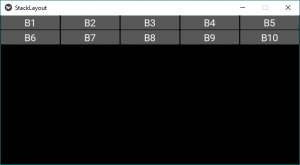
这是针对方向”lr-tb”的。首先, 将小部件从左到右添加, 然后从上到下添加。
注意:如果要更改方向, 只需将第31行的方向更改为以下任何方向-
For row wise orientation use:
-'lr-tb'
-'lr-bt'
-'rl-tb'
-'rl-bt'
For column wise orientation use:
-'tb-lr'
-'tb-rl'
-'bt-lr'
-'bt-rl'下面是图片输出, 上面所有方向–
对于行方向使用:
'lr-tb'输出如下:
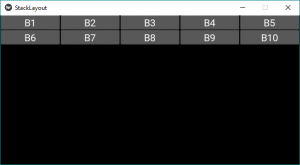
'lr-bt'输出如下:
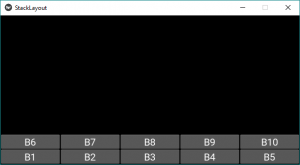
'rl-tb'输出如下:
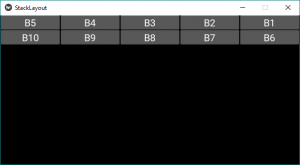
'rl-bt'输出如下:
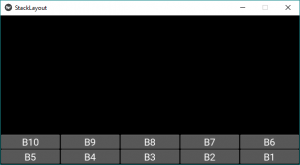
对于列方向定向, 请使用:
'tb-lr'输出如下:
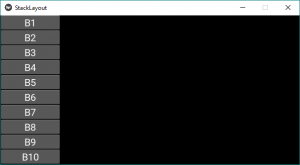
'tb-rl'输出如下:
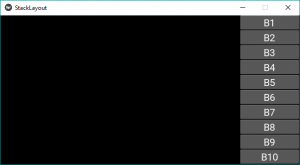
'bt-lr'输出如下:
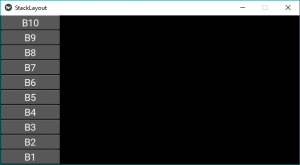
'bt-rl'输出如下:
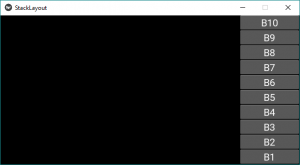
首先, 你的面试准备可通过以下方式增强你的数据结构概念:Python DS课程。
 srcmini
srcmini
评论前必须登录!
注册